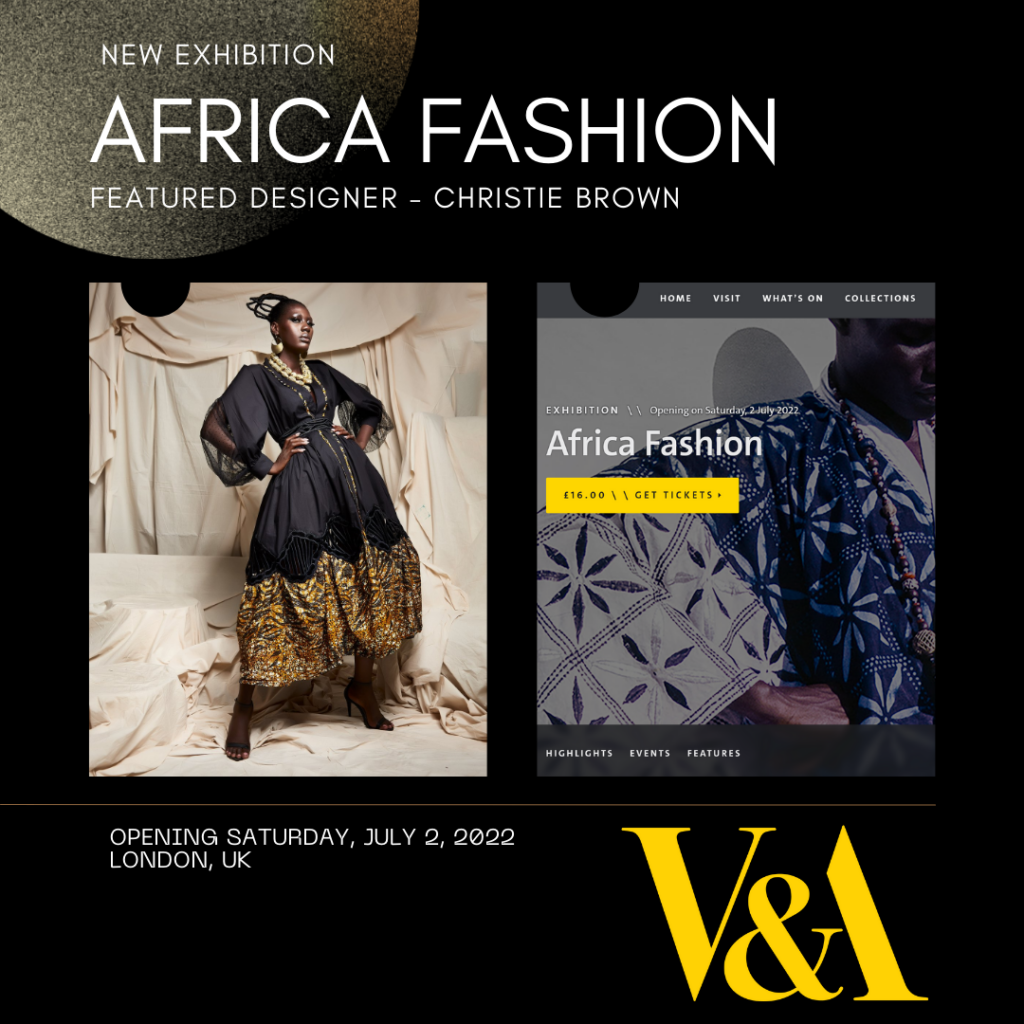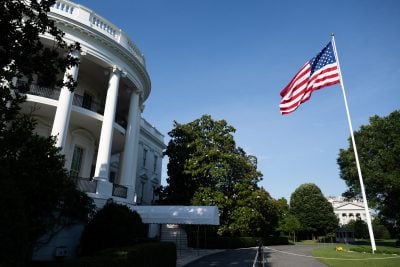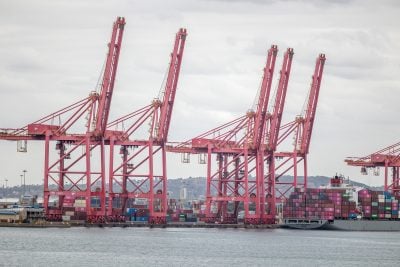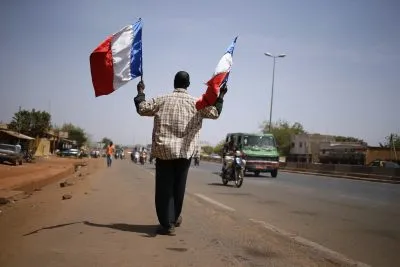Like many women in Ghana, Christie Brown was a seamstress and Aisha Ayensu, her granddaughter, first discovered a passion for sewing by helping to thread her machine.
It would likely not surprise Brown that Ayensu followed in her footsteps to start her own fashion house, named Christie Brown in her honour – sewing, embroidery and textiles have a long history in Ghana spanning generations.
What Brown would not have expected is the name Christie Brown on boxes of luxurious blazers and flowing dresses, all in the bold weaves, intricate embroidery and traditional tailoring of Ghana, being sent to customers around the world and headlining the new Africa Fashion exhibition at London’s influential Victoria & Albert Museum.

Celebration of African creatives
“African fashion creatives lead the way when it comes to cutting edge contemporary global fashions,” says Christine Checinska, the curator behind the exhibition, which opens on 2 July.
“The exhibition is a timely and conscious celebration of a selection of creatives from the corners of the continent, in a sense giving a glimpse of the glamour and the politics characteristic of the scene.”
With 45 designers from over 20 African countries featured across two floors of the museum, the exhibition points a spotlight on a sector of the fashion industry that, while often overlooked, has been growing rapidly during the past decade.
“Middle East and Africa apparel grew by 13% in value terms in 2021 and this strong growth is primarily as a result of strong recovery in some markets following the sharp decline in demand during hard lockdown,” says Rubab Abdoolla, an analyst at Euromonitor International, a market research provide.
Euromonitor estimates the market to be valued at $92bn in 2021 and expects it to grow at a compound annual growth rate of 3% over the next five years in the Middle East and Africa.
Reputation makeover
“Africa has a long way to go before cementing its name in the international fashion industry,” Abdoolla warns, despite its strong growth.
“In my opinion, there is a strong bias when it comes to African fashion – the first thing that comes to people’s mind are African prints when in reality African fashion is much broader.”
As a result of the reputation of African fashion, African consumers themselves crave Western and other international brands, which are often seen as status symbols, according to Abdoolla. However, the new attention on African fashion, both as an industry and as an art form, could go far in shifting perception and boosting sales.
African fashion designers are increasingly being worn by celebrities. Pop musician Beyoncé Knowles helped propel Senegalese designer Sarah Diouf’s Tongoro brand to fame when she wore a patterned dress and wide-leg pants on holiday.
Late South African designer Quiteria Kekana, who used to design for Knowles, received a flurry of media attention and was recognised at Mercedes-Benz Fashion Week Kigali this past spring.
International celebrities like Naomi Campbell, Zendaya and Angela Bassett are a few others who have drawn attention to African fashion designers by wearing their work.
This trend can also be seen in art, fashion’s sister industry. The designer Selly Raby Kane, who is featured in the V&A exhibition, recently showed her work at the Dakar Biennale. Thebe Magugu is building an international name in artistic films and installations, as well as fashion design.
This creativity is what Checinska says excited her most about African fashion.
“What excites me is the way in which contemporary creatives are changing the scope of what it is to be a designer. Designers like these demonstrate the power of creativity and in so doing are shifting the geography of fashion,” she says.
As African fashion has inched its way into the spotlight, experts have seen an accompanying shift toward local production within the continent. This has seen local retailers create their own private labels, like Superbalist and Edgars in South Africa, for example.
“We can expect the apparel industry to register growth, assuming major retailers in the continent continue to source their products locally,” Abdoolla says.
Cut for the future
Ayensu, an award-winning fashion designer who has created outfits and stage costumes for Beyoncé has watched the appetite for her designs grow both within Africa and globally.
Today, Christie Brown has a buzzing flagship store in Accra, Ghana, and robust e-commerce operations that ship worldwide – the US and Europe are its biggest markets. The company has hired more than 70 people from the local community and Ayensu has ambitious plans to continue expanding, including entering the wholesale business.
Ayensu believes that having two of her pieces included in the exhibition at the V&A will go far in turning these dreams into realities.
“It is such a great milestone for us, because it cements our place in history,” says Ayensu. “It puts Christie Brown in front of the right people. It creates awareness for the brand and piques the curiosity of people around the world – not only to research African brands, but also to patronise African brands.”
Ayensu explains that this patronage goes beyond herself and the Christie Brown name. She intentionally chose one of the poorest neighbourhoods of Accra to build her factory and workshop. She recalls that the area was forgotten, rural and flooded with poverty when she selected it more than 10 years ago.
She set out to build a state-of-the-art, eco-friendly manufacturing hub in the neighbourhood and hire people from the community. During the course of the next decade, she watched the neighbourhood change.
As the neighbourhood filled with workers, it became colourful and lively. Vendors arrived and set up stalls to sell food to the employees. Today, it is a very different place.
Her optimism for African fashion is captured in the two pieces by her that the V&A selected, one from the collection “Conscience” and the other from the collection “She is King.”
Both collections encourage customers to pay attention to their inner voice and to own their worlds – “becoming king over every aspect of their lives,” says Ayensu. “It’s a wonderful time to be in this space. Finally, we are being recognised on our own merits. I want to show the world that we are able to create world class luxury brands here.”
Want to continue reading? Subscribe today.
You've read all your free articles for this month! Subscribe now to enjoy full access to our content.
Digital Monthly
£8.00 / month
Receive full unlimited access to our articles, opinions, podcasts and more.
Digital Yearly
£70.00 / year
Our best value offer - save £26 and gain access to all of our digital content for an entire year!
 Sign in with Google
Sign in with Google 



